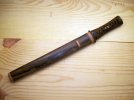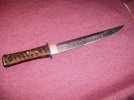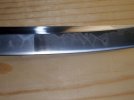- Joined
- Jun 4, 2011
- Messages
- 147
Hi, This is high layer Osoraku Zukuri Tanto I finished a couple weeks ago. Blade is around 10" forged from W-2 and 1075 folded out to around 3,600 layers. Clay coated and quenched in water. Saya is Zircote w/ chestnut burl end caps, brown ito over black ray skin, heat blued Damascus tsuba and fittings provided by the customer.
Sorry for the bad pics, that is something I'm working on...
Thanks for looking, feedback is appreciated. -Justin
Sorry for the bad pics, that is something I'm working on...
Thanks for looking, feedback is appreciated. -Justin




